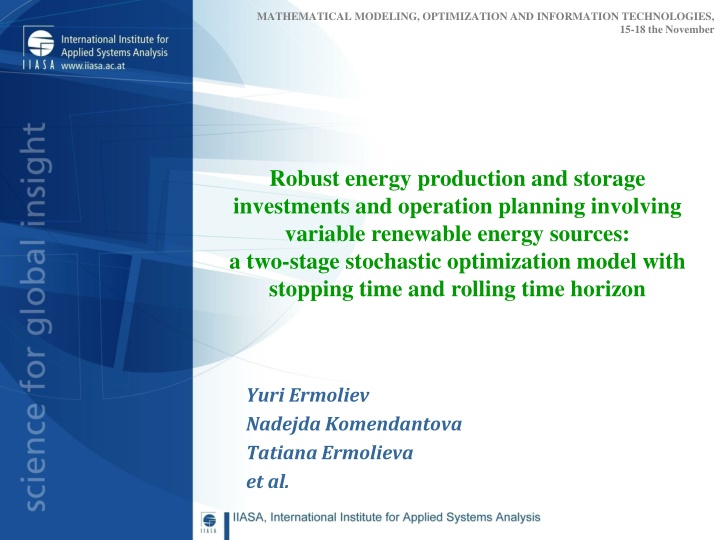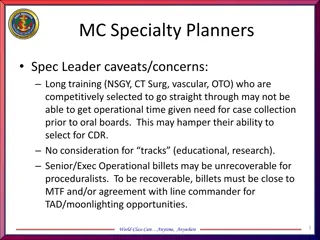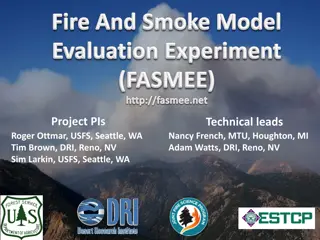
Robust Energy Production and Storage Investments: Two-Stage Stochastic Optimization Model
Explore a comprehensive two-stage stochastic optimization model for robust energy production and storage investments involving variable renewable energy sources. Addressing challenges of renewable resources' stochastic nature, the model optimizes operations to manage supply-demand imbalances effectively, enhancing system resilience and reliability.
Download Presentation

Please find below an Image/Link to download the presentation.
The content on the website is provided AS IS for your information and personal use only. It may not be sold, licensed, or shared on other websites without obtaining consent from the author. If you encounter any issues during the download, it is possible that the publisher has removed the file from their server.
You are allowed to download the files provided on this website for personal or commercial use, subject to the condition that they are used lawfully. All files are the property of their respective owners.
The content on the website is provided AS IS for your information and personal use only. It may not be sold, licensed, or shared on other websites without obtaining consent from the author.
E N D
Presentation Transcript
MATHEMATICAL MODELING, OPTIMIZATION AND INFORMATION TECHNOLOGIES, 15-18 the November Robust energy production and storage investments and operation planning involving variable renewable energy sources: a two-stage stochastic optimization model with stopping time and rolling time horizon Yuri Ermoliev Nadejda Komendantova Tatiana Ermolieva et al.
European Commission adopted the new Strategic Energy Technology (SET) Plan. The SET Plan aims, among other goals, to contribute to achieve the research and innovation objectives of the EU to become the global leader in renewable energy Increasing deployment and reliance on renewable resources Main challenge associated with renewable energy sources is their stochastic and dynamic characteristic. Variable renewable energy sources (wind and solar power) are non-dispatchable due to their fluctuating nature, as opposed to controllable and relatively constant sources. The intermittent characteristics and the spatial complexity of renewable energy generation and transmission and various storage capacities require specific modeling approaches and performance indicators enabling to manage stochastic supply-demand imbalances to avoid or minimize the likelihood of systemic failures associated with e.g. periods of unstable energy generation or periods of low or high energy loads. The need for stochastic modeling and optimization
Model-based planning Emerging risks deregulation, decentralization Multiple energy/electricity generation companies/entities Requires strict regulation of energy/electricity dispatch Systemic risks and vulnerability of energy markets Transboundary issues and energy balancing Optimal dispatch and pick prices Stochastic threats from wind, solar, hydropower Stochastic supply vs demand depends on weather Short- and long-term energy systems planning Uncertainties of climate change Scarcity of resources, e.g. water scarcity Technological uncertainties, future electricity consumption, e.g. electric cars, etc. Rare natural resources requirements (in EU?) Methodological risks application of inadequate model/method Stakeholder involvement and model-based dialogue Changing risk perception via a model 3
Spatio-temporal planning Water resources Human life standards Coal mining and processing Demand Land Use Climate Change Temporal resolution of the anticipative-adaptive energy planning model
= t The goal of the strategic model is to identify such technologies with capacities installed at the beginning of year (or of planning period) t that the demands representative period J j ,..., 1 = and year t are satisfied. t x , i , i ,..., 1 = i ix , , ,..., 1 i n t j d , in each = t x , i , ,..., 1 i n n i = t Assume planning time horizon of T years. Let installed in year t, 0 , n i ,..., 1 = , t ,..., 1 = iL t i i i i x x S S + = , where In these equations for the simplicity of exposition we assume that converted to electricity end-use to satisfy demand. For each period we introduce the production plan decisions ix be the capacity of technology i , T t ,..., 1 = ,..., 1 i n t iS - total supply by i available in t, . Then Year 1 Year t Year T Years t , (1) ix T Periods (1,j) Periods (t,j) Periods (T,j) d1 t t t t j t J d t d2 t d c P y t 1 t t t (2) ic1 ic2 ij c iJ t t t t iP1 iy1 iP2 iy2 ij P iJ t iJ t = 0 ijy t t 1 t iL is the lifetime of technology i, iS is initial capacity of i existent before . Figure 1. Temporal resolutions of the strategic planning model. t iS is energy already J : 1 = within = ,..., 1 j t T t ij y defining how much of technology i operates : T n n J = t 1 where = i 1 + t t i t ij t t ij ( ) C x c T y , (6) i j t : 1 = j d , in period j to satisfy demand = i 1 t i ij ij S y , i 1 = 0 , where ij , 1 period j in t ( j J = = 1 1 i j t t ij c - unit production cost C - is unit investment cost for technology i in year t, n i = = = t ij t j , , , (3) ,..., 1 ,..., 1 y d j J t T t j T is a duration of period j in t that can also (including fuel costs) for i in period j in t, and be denoted as t ijy t ij . q t t : 1 = = , , , (4) ,..., ,..., 1 n j J t T , i j The energy efficiency and aging processes may be introduced in equation (2) as iL t i i i i i x x S e S + = , where process in a detailed technology-based manner as suggested in Section 2.1.5. Investment constraint may be introduced for each T t ,..., 1 = =1 t ij y (5) 1 t t t t (7) t ij t 1 may be interpreted as availability factor of technology i operating in t iedenotes depreciation (aging) rate in t. Aging can be also modeled as a dynamic = t ij 0 for not yet existing technologies). as n t t i t . C x I i i
There is a set E of available energy sources (gas, coal, solar, wind, water, biomass, hydrogen). Each technology i is then characterized by its set of input-output (conversion) coefficients , which convert the unit input energy type l into different energy technology m i ,..., 1 = to satisfy demand = in T t ,..., 1 = . Define nonnegative decisions energy type k . Therefore, , t i ij ijk S y . t ilk a t ilk a units energy type k . In this case, i denotes d of energy type t kj = in ,..., 1 k K t ijk y operating in period j of period ,..., 1 j n t ilk t ijk t jk (8) a y d l i t t (9) Thus, t ilky t ijk is the input of energy l required to satisfy demand in energy k by production a , l i t ijk y for technology i. Operation costs of technology i are spread over technology life plan iL . For simplification of notation, total operation cost t ijlky t ijk of technologies in t in all q , , , i j l k periods j includes resource costs and conversion costs from i to k .
: 1 = t t T Strategic first stage investment decisions horizon 1 = t using a perception of stakeholders about potential future scenarios ) ( , ) ( of costs and energy demands dependent on stochastic parameter . Here we use to denote a sequence of ,..., , ( 2 1 = independent parameters which may affect outcomes of the strategic model, e.g., market prices, weather conditions. In general, there are different components of characterizing the variability of the demand and other components uncertainties associated with strategic and operational decisions. Therefore, functions ) ( , ) ( depend in general only on some components of dependence on for simplicity of notation. There are essential differences between basic deterministic model (1)-(6) and its stochastic version. Because strategic decisions only on t, equations (1), (2) remain the same. Second stage adaptive operation decisions are made after observing real demands and costs. They depend on observable scenario , i.e. ) ( ij ij y y = . Therefore, any choice of investments decisions feasible second stage solutions ) ( satisfying following equations (13)-(15) for all : = i 1 t i ij ij S y ) ( , n i : 1 = , J j : 1 = , T t : 1 = , 0 ) ( , where iL t i i i i x x S S + = , 0 , n i : 1 = , T t : 1 = . ix , , are made at the beginning of planning ( t , ) i C t t j d ij c of in general of uncertain vectors ,..., ) t T t , say, components , t dem t t str t ope characterizing The feasibility of constraints (13)-(15) for any scenario can be guaranteed by assuming the existence of a back-stop technology with high operating costs that can also be viewed as purchasing without delay but at high price. Without loosing generality we assume that for any period j and time t it is the same technology stage model is formulated as minimization of expected total costs function = = = ( , ) C i , although we indicate t t ij c id t = 1 i . Then the basic dynamic stochastic two- t ix depend t ij y T n J = + = t t i t ij t t ij ( ) ( ) ( ) ( ) F x E C x c T y i j : 1 = t t t t T ix , , does not yield 1 1 1 t i j T n J t ij y = t 1 = j + = t t i t ij t t ij (18) ( ) ( ) C x E c T y i j = 1 1 i n T n J : 1 = = : 1 = t ij t j t T , , , (13) ( ) ( ) y d j J = t 1 where available in unlimited amount, = j + t t i t ij t t ij min ( ) ( ) C x E c T y i j t ji ( ) y = 1 1 i t t (14) C = = ( t t t i C is expected investments cost, . Because the back-up technology is C for all j where C is a large enough ) E C ct ; i ,..., 1 i j= 1= 0 t 0 , C t T 1 t ij y (15) for some scenarios , then this indicated the existence of 1 = i ) are not able to satisfy demands. The following t ij y positive number. If optimal risk that installed technologies (excluding example illustrates this risk. 1 t t t (16) t (17) ix
The minimization of function (20) includes now additional subproblems on minimization of functions with respect to 0 , T t ,..., 1 = , + = i i t t t z x C E z z R ) ( , 0 max ) 1 ( ) ( tz 1 t t (21) t VaR and CVaR risk measures. In model (13)-(18) the variability of outcomes is characterized n t is a risk factor controlling that stochastic costs ( t t i subject to , where ) don t 0 C x tz i ( ( t t ) ) ij y ij c by stochastic second stage operational decisions with unit costs . Although = 1 i t exceed a desirable robust safety level risk function (20) yields optimal values financial applications are well known as the Value at Risk indicator tz . If the safety vector * tz satisfying the following safety constraints which in , then the minimization of 1 ( t t strategic first-stage decisions ix have random costs , total cost function (18) ignores ) i C n . If total stochastic costs ( C = ( t t t t i their variability by using mean values ) ) C x EC i i i = 1 i ( = = t t i , . (22) Pr ) ,..., 1 ob C x z t T cannot well enough approximate a normal distribution, then instead of the mean value of these i t t costs it is advantageous to use in equation (18) the median or other quantiles, especially when these costs may be affected by extreme events. This variability can be easily modeled by Sub-problems (21) correspond to Conditional Value at Risk (CVaR) minimization. This ( t t ) ij y additional decision variables which jointly with variables ix , minimize the 0 tz n problem has the following interpretation. Foreseen investments costs ( t t i at time t are ) C x function i = 1 i t planned to be covered by ex-ante credit at price and ex-post borrowing 1 T J = t subject to constraints (13)-(17). = j + + 1 t t i t ij t ij 1 ( ) max , 0 ( ) ( ) ( ) (20) z E C x z E c y t t i t n = i t t i max , 0 ( ) fore relatively greater price. This provides more flexibility C x z 1 1 i t 1 (robustness) compared only with ex-ante planning of investments using mean values of ( t perceived unit costs . It is also important that ex-ante credit is evaluated by (22) as the ) EC i t , = quantile with desirable safety levels , rather then mean values which are ,..., 1 t T especially misleading in the case of non-normal distributions.






















